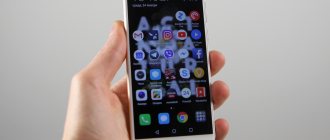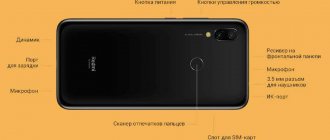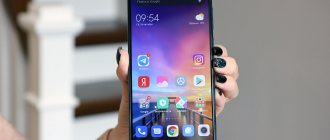Design and ergonomics
At the beginning of the review, we note that the smartphone received a design very similar to the one that was used to create the Redmi Note 4. Here we see the same metal, a convenient plastic divider at the bottom, the usual curve on the back cover and polished edges. The connectors and keys are located similarly, and the same can be said about the fingerprint scanner and camera. Are there any differences at all? If you look closely, you can find them. For example, this includes the location of the dual flash, as well as the redesigned sensors on the front of the panel. The plastic plug immediately above the camera has also changed slightly.
Although we are accustomed to the Note console slowly bringing to mind thoughts of a “shovel,” in this case everything is more than decent. For a gadget with a 5.5-inch screen diagonal, the Xiaomi Redmi Note 4 Pro looks just great and is an example of compactness. Although there are, of course, complaints from users that it is not so easy to operate the device with one hand, can you show me which mobile phone of this size is easy to do this on?
The navigation keys are touch sensitive and not backlit. This is also a difference from Redmi Note 4, where there are LEDs under the sensors. Although this innovation was considered, because Note 4 Pro is, rather, a continuation of the Redmi 3s model, in which the backlight was replaced with a material that reflects light. At the same time, a qualitative difference was the appearance of a new, more advanced display.
Battery
One of the bright sides of the Redmi Note 3 was its long battery life. According to the manufacturer, Redmi Note 4 works 25% longer. This was achieved with a more energy-efficient processor and a larger battery.
And official statements are confirmed. In active mode, the operating time of the new product is approximately 20-25% longer than that of the previous generation. In the case of Redmi Note 3 it was about 7-8 hours of work with the screen always on, and in Redmi Note 4 it was about 10-11 hours.
Unfortunately, the smartphone does not have fast charging technology, but the battery fills with energy approximately as quickly as the third generation.
Display
The gadget received a Full HD display with a diagonal of 5.5 inches. This is perhaps the ideal solution for this screen size. On the surface there is the usual protective glass with a 2.5D effect. And even if it is not very convenient for someone to use such a smartphone with one hand, without a doubt, watching videos from it leaves unforgettable emotions.
The IPS panel has replaced the AMOLED matrix, and although because of this the color rendition is not at an ideal level, in fact, it is difficult to notice with the naked eye. Through the settings it is easy to adjust the color temperature, which expands the user's capabilities.
The developers were never able (or did not want) to fix the auto-brightness adjustment. The smartphone does not cope with this function in the best way. If you manually adjust this parameter, the device will allow you to read from the screen in bright light and at night.
The sensor, on the other hand, is as usual good. It recognizes up to ten simultaneous touches.
Appearance
Compared to the previous generation, the body shape of Redmi Note 4 has become less rounded. Therefore, the device looks more compact, although this is not entirely true - the body has become 1 mm longer.
Almost nothing has changed on the front panel, but otherwise the device has become more symmetrical. One of the disadvantages of Redmi Note 3 was the sensors and the microUSB port on the left side that were slightly shifted from their usual position. All this was fixed in Redmi Note 4. On top of the display in the shape of a cute face are the front camera, earpiece and sensors.
At the bottom of the screen there are soft-touch buttons for controlling the Android operating system. Button illumination is uneven. The right back button constantly looks like it's getting more light. This may be a sample specific issue.
The large 5.5-inch screen is covered with protective glass. It does not get scratched if you run a knife hard across the surface. There is a rounding with a 2.5D effect along the entire perimeter of the glass. The Chinese have finally started using it in budget smartphones.
On the left side of the case there are unlock and volume control buttons. And on the right there is only a slot for microSIM and microSD cards.
On the top edge you can find a 3.5 mm audio jack with a conversational microphone and an infrared transmitter. At the bottom there is a microUSB, another microphone and main speaker grilles.
The design of the rear panel is familiar to Xiaomi. This is a metal lid in a plastic “cover”. This way, the effect is achieved as if the entire back cover is made of metal, but this is far from the case. In fact, the entire backdrop is covered in plastic, but it is covered with a thin aluminum strip.
In general, the appearance of the smartphone has become more pleasant - it has been polished. In addition, the build quality has improved. The third generation of Redmi Note was not famous for its good build - the body easily bent and creaked. Redmi Note 4 feels more solid and durable, but the manufacturer has not gotten rid of the creaking of the body. But what else can you expect for this price?
Sound
At the bottom end there are two slots for speakers, although in fact they each contain one speaker and a microphone. The sound of the phone without headphones is at an average level - typical for the Redmi line. Low frequencies are desperately lacking. A headset is not included, but you can connect any of your own headphones. In them, the sound is transmitted much clearer and more complete.
And in terms of sound quality during a conversation, everything is absolutely fine. You can hear your interlocutor well, as well as he can hear you.
Camera and sound: cheap but cheerful
Perhaps the multimedia capabilities of the Xiaomi Redmi Note 4X are its worst side. Even the main camera can be from several manufacturers. Undoubtedly, for the money the camera allows you to take excellent pictures. In good lighting - even artistic ones.
With proper skill, you can get good macro photographs. The examples shown are much better than the photos taken by peers (the only exceptions are the Huawei couple).
Everything changes in the absence of good lighting. Yes, in the twilight HDR helps a little - without it, the photos turn out even more blurry and colorless. Evening photos and photos with flash are present nominally. Exactly the price of a smartphone.
There is only one speaker in Xiaomi Redmi Note 4X. The volume is sufficient for conversations in noisy places and for ringtones. But it cannot be called musical, absolutely impossible - although it does not distort speech.
However, the same can be said about the sound of a smartphone in headphones. System “improvements” bring the device to the average level, but you shouldn’t expect anything supernatural. This is a smartphone cheaper than 10 thousand. But it sounds very good with any Xiaomi headphones. Better systems for most of our readers. Even via Bluetooth – thanks to aptX support.
The fact that the Xiaomi Redmi Note 4X has a “so-so camera” with mediocre sound is almost the best in its class (if we are considering new devices)!
Cameras
Compared to the previous Red Mi model, the camera has remained virtually unchanged. We see only cosmetic adjustments. For example, the aperture is already f/2.0, not f/2.2. In terms of camera expansion, the cameras are identical – 13 megapixels for the main one and 5 megapixels for the front one. If you want to shoot a video, the best available quality is Full HD.
During the day, color rendition is at an optimal level, but as lighting conditions deteriorate, the quality of the photo begins to drop noticeably. True, if you manually set the photography settings yourself, there is a chance to get a good photo. In practice, the HDR mode helps. In the case of recording video in low light conditions, everything is somewhat worse. It is almost impossible, even through settings, to optimize the camera so as to obtain high-quality video recording in the dark. Image stabilization is weak on both legs, and noise inevitably appears in the recording.
Among the pleasant moments, we note the quick launch of the “native” application for photos and videos. When moving to editing photos in the gallery, the speed is also acceptable. That is, as is usually the case with Redmi, the camera is not amazing, but leaves a satisfactory impression.
Let's talk about the camera
Let's continue our review by talking about the camera. The main camera of the Prime model received a 13-megapixel module. It is known that at the time of the smartphone’s release, the module used here was the latest development by Omni Vision. The five-element lens has an aperture of f/2.0. Also, the camera is equipped with a phase detection autofocus mechanism, as well as a two-color LED flash. If we talk about the front camera, it has a 5-megapixel module with a lens aperture of f/2.0.
Now let's talk about cameras in a little more detail. The main camera takes pictures with excellent color reproduction and does not make any errors in exposure. By the way, the pictures come out really well detailed in good artificial and daylight lighting. If there is a lack of light, then the photographs begin to have noise and lose detail. The front camera has a fixed focus and takes pictures of pretty good quality, but only in good lighting.
The review should continue with the fact that the camera interface is extremely simple and will be understandable even for a beginner. There are 8 shooting modes to choose from:
- voice;
- timer;
- panorama;
- scene;
- night;
- manual;
- improvement;
- alignment.
The manual mode can be called stripped down - the user can independently set only the white balance and ISO values. But you cannot change the same distance or shutter speed here. The description of the cameras should be supplemented by the fact that there is also a separate settings menu where you can turn on the framing grid, change the format and size of the frame, assign an action to the volume key, and also change parameters such as sharpness, saturation, contrast and exposure metering.
The Prime camera can shoot video files in Full HD resolution at 30 FPS, as well as slow-motion video in HD resolution.
Autonomy
Although the body of the phone is very thin, it houses a 4100 mAh battery. And although the figure looks fantastic, in reality, taking into account the screen size and energy consumption, this gives us about 5 hours of active use of the smartphone in a row. If during the day you limit yourself to surfing the Internet, listening to music and making calls, then, in principle, one charge should be enough for a whole day of using the phone. The phone is fully charged in about 2 hours.
Give gifts
Fitness bracelet Xiaomi Mi Band 3 Silicone strap as a gift!
990 ₽
Fitness bracelet Xiaomi Mi Band 4 Silicone strap as a gift!
2 490 ₽
QC Test and MTK engineer mode:
To get started, you can enter the following code in the number entry window: *#*#6484#*#* This code allows you to go to the test menu, where you can test the phone’s hardware, as well as get fairly detailed information about both hardware and software provision. To access the engineering menu, you must enter the following code: *#*#3646633#*#* (left screenshot, I’ll tell you about the right one below)
We do everything here at our own peril and risk. I did not do anything.
Performance
In comparison with Redmi Note 4, the “filling” of the gadget has changed minimally. Now inside is a Qualcomm Snapdragon 625 chip with eight cores and a frequency of 2 GHz. There is some decrease in performance compared to the first model. If you read the Redmi Note 4 review, then remember that this phone gave up to 90 thousand points on AnTuTu. The pro version gives out up to 70 thousand. But this made it possible to increase the autonomy of the smartphone.
Depending on the configuration, RAM can be 3 or 4 GB, and built-in memory can be 32 or 64 GB. Additionally, you can use a memory card. The software base is familiar - Android 6 with MIUI8 shell. The Chinese version of the firmware is not Russified, but it will not be difficult to reflash the gadget yourself using a laptop or computer.
Everything about Xiaomi Redmi Note 4 and its modifications: characteristics and network ranges
Background
Our beloved Xiaomi company in August 2020 officially presented its new budget phablet Redmi Note 4, which was not radically updated, but enough to be called the 4th version. Redmi Note 4 received a new more strict and monolithic design, an improved ten-core Mediatek Helio X20 chipset, a Mali T880 graphics chip, 16 GB, 32 GB, and then 64 GB of internal memory, as well as a new camera module. By the way, the main camera received an unexpected “downgrade” to 13 megapixels, however, the shooting quality has become significantly better. In fact, Xiaomi slightly modernized Redmi Note 3. And then the number of versions and modifications of Redmi Note 4 began to grow like a snowball and confused many buyers. Let's try to understand the diversity of these wonderful phones, so that there are certainly no questions about “Global Version”, “Band 20” and the like.
IMPORTANT
The global version of the Redmi Note 4 powered by the Snapdragon 625 chip is specifically identified by the red 'Global Version' inscription on the box. You can always buy this version of the smartphone on our website.
Chronology and versions
•
In August 2020, Redmi Note 4 based on the Helio X20 chip was introduced in two versions: 2+16 GB and 3+32 GB.
•
A little later, versions of Redmi Note 4 with memory 3+64 GB and 4+64 GB went on sale. Then, at the end of January 2020, to the delight of fans of Qualcomm products, Xiaomi introduced the Indian version of Redmi Note 4, which was already powered by the Qualcomm Snapdragon 625 processor, but slightly different in design from the original version of the phablet: plastic top and bottom inserts instead of metal ones. Moreover, this model had its supported bands cut off and was, in fact, a local offer for India. Therefore, mi fans began to wait for the hero of early rumors of a certain, different version of the phablet, called Redmi Note 4X on Snapdragon 625, but with support for frequencies.
•
At the same time, the 2+16 GB versions of the first Chinese Redmi Note 4 were removed from sale.
•
Time passed and Redmi Note 4X was presented based on Snapdragon 625, memory 3+32 GB and 4+64 GB. All the same plastic inserts, a little more supported frequency ranges, but the coveted Band 20 never appeared.
•
And just a few months ago it happened. Xiaomi introduced a new version of Redmi Note 4 Global Version. There are Taiwanese, Singaporean and Malaysian versions on the market. They all support Band 20.
•
Later, Xiaomi introduced another Chinese version of Redmi Note 4X with 4+64 GB with plastic inserts and... Helio X20 chip. Thus, versions of the phablet with 4+64 GB and Helio X20 are presented in different designs and for different markets: the first Chinese Redmi Note 4 is completely metal and the Chinese Redmi Note 4X with plastic inserts.
In total, there are four versions of Redmi Note 4th generation
(chip, RAM/memory)
| Chinese Redmi Note 4 | MTK, 3/32 | MTK, 3/64 | MTK, 4/64 | — |
| Indian Redmi Note 4 (2016100) | SD, 2/32 | SD, 3/32 | SD, 4/64 | — |
| Chinese Redmi Note 4X (2016101) | SD, 3/16 | SD, 3/32 | MTK, 4/64 | SD, 4/64 |
| Global Redmi Note 4 (2016102) | SD, 3/32 | SD, 4/64 | — | — |
Differences in network ranges of models with Snapdragon 625 chip
| Indian Note 4 | Chinese Note 4X | Global Note 4 | |
| 2G GSM | B2/ B3 /B5/B8 | B2/ B3 /B5/B8 | B2/ B3 /B5/B8 |
| 3G WCDMA | B1/B2/B5/B8 | B1/B2/B5/B8 | B1/B2/B5/B8 |
| 4G FDD-LTE | B3/B5 | B1/B3/B5/ B7 | B1/B3 / B4 B5/B7 /B8/ |
| TDD-LTE | B40 | B38/B39/B40/B41 (2555-2655 MHz) | B38/B40 |
| TD-SCDMA | — | B34/B39 | — |
Differences in colors
Indian Redmi Note 4 (2016100) : black, gold, dark gray. Chinese Redmi Note 4X (2016101) : turquoise (Hatsune Miku Limited Edition), pink, champagne gold, platinum silver, matte black. Global Redmi Note 4 (2016102) : pink, champagne gold, platinum silver, matte black.
Good to know
- The Chinese version has Bluetooth 4.2, while the global and Indian versions have Bluetooth 4.1.
- The Global Redmi Note 4 comes with a Euro plug, so no adapter is needed.
- Please note that the absence of B20 does not mean a lack of support for 4G LTE networks, it’s just that some operators may not use them. There are no main frequencies for our region except in the Indian version of the smartphone. In Europe and Russia, as well as in the former Soviet republics, it is often useful to have B20 (800 MHz). It is used by both large operators and smaller operators. Moreover, the latter B20 may be the only frequency for 4G LTE.
- Here you can check which frequencies operators support in your city.
- You cannot cut or add frequencies using firmware.
General characteristics of Snapdragon 625 phones
CPU
: Snapdragon 625, LPP FinFET 14 nm;
8 cores at 2.0 GHz; Battery
: 4100 mAh, 5V/2A, non-removable, lithium polymer;
Graphics
: Adreno 506, 650 MHz;
RAM type:
LPDDR3;
Memory type
: eMMC 5.0;
Camera
: CMOS sensor 13 MP, front 5 MP;
Housing
: metal and plastic inserts, 2.5D glass on the screen;
Display
: FullHD 5.5”;
Dimensions
: 151x76x8.45 mm;
Weight
: 165 grams;
SIM cards
: Nano-SIM + micro-SIM or Micro-SIM + micro SD memory card;
Navigation
: GPS, AGPS, GLONASS, BeiDou;
Connectivity
: Bluetooth HID, Wi-Fi Display, Wi-Fi Direct, 802.11 a/b/g/n.
You can view the full characteristics of the models and order on our website .
Products that may interest you:
Global Version
Global Version means that the product is released for the global market and meets international quality standards.
Rostest is a certification mark that guarantees that the device complies with all Russian norms and standards for environmental protection and user health. This sign does not imply any additional differences or advantages over other devices.
-13%
Fitness bracelet Xiaomi Mi Band 4 (black) (XMSH07HM)
2190 1,890 rub.
Item in cart
Global Version
Global Version means that the product is released for the global market and meets international quality standards.
Rostest is a certification mark that guarantees that the device complies with all Russian norms and standards for environmental protection and user health. This sign does not imply any additional differences or advantages over other devices.
-3%
DVR 70mai Dash Cam Pro EU (1944p, black) (MidriveD02)
5390 5 190 rub.
Item in cart
Global Version
Global Version means that the product is released for the global market and meets international quality standards.
Rostest is a certification mark that guarantees that the device complies with all Russian norms and standards for environmental protection and user health. This sign does not imply any additional differences or advantages over other devices.
-8%
Xiaomi Mijia Sweeping Robot 1S (white) (SDJQR03RR)
22290 20 290 rub.
Item in cart
Global Version
Global Version means that the product is released for the global market and meets international quality standards.
Rostest is a certification mark that guarantees that the device complies with all Russian norms and standards for environmental protection and user health. This sign does not imply any additional differences or advantages over other devices.
-9%
Xiaomi Mijia 1C Robot Vacuum Cleaner Sweeping Vacuum Cleaner (white) (STYTJ01ZHM)
18690 16,990 rub.
Item in cart
Global Version
Global Version means that the product is released for the global market and meets international quality standards.
Rostest is a certification mark that guarantees that the device complies with all Russian norms and standards for environmental protection and user health. This sign does not imply any additional differences or advantages over other devices.
-6%
New!
Fitness bracelet Xiaomi Mi Band 5 (black)
2890 2,690 rub.
Item in cart
Global Version
Global Version means that the product is released for the global market and meets international quality standards.
Rostest is a certification mark that guarantees that the device complies with all Russian norms and standards for environmental protection and user health. This sign does not imply any additional differences or advantages over other devices.
-18%
Xiaomi JIMMY Handheld Wireless Powerful Vacuum Cleaner (JV51)
12990 10 590 rub.
Item in cart
Global Version
Global Version means that the product is released for the global market and meets international quality standards.
Rostest is a certification mark that guarantees that the device complies with all Russian norms and standards for environmental protection and user health. This sign does not imply any additional differences or advantages over other devices.
-12%
Xiaomi Mi Air Purifier 2S (AC-M4-AA) (white)
11890 10 390 rub.
Item in cart
Global Version
Global Version means that the product is released for the global market and meets international quality standards.
Rostest is a certification mark that guarantees that the device complies with all Russian norms and standards for environmental protection and user health. This sign does not imply any additional differences or advantages over other devices.
-15%
Smartphone Xiaomi Redmi Note 8 Pro 6/128 Gb (Global, black/Mineral Grey) (M1906G7G)
22490 18,990 rub.
Item in cart
Global Version
Global Version means that the product is released for the global market and meets international quality standards.
Rostest is a certification mark that guarantees that the device complies with all Russian norms and standards for environmental protection and user health. This sign does not imply any additional differences or advantages over other devices.
-23%
Xiaomi Mi Robot Vacuum robot vacuum cleaner (white) (SDJQR01RR)
22990 17 490 rub.
Item in cart
Global Version
Global Version means that the product is released for the global market and meets international quality standards.
Rostest is a certification mark that guarantees that the device complies with all Russian norms and standards for environmental protection and user health. This sign does not imply any additional differences or advantages over other devices.
-15%
Smartphone Xiaomi Redmi Note 8 Pro 6/128 Gb (Global, green/Forest Green) (M1906G7G)
22490 18,990 rub.
Item in cart
⇡#Design, ergonomics and software
If in the case of flagships (Mi5, Mi6, Mi MIX) Xiaomi allows itself some experiments (non-standard shape, ceramic case cover), then when it comes to truly mass-produced models, everything becomes extremely simple. But not primitive - even a device costing 10 thousand uses 2.5D glass to decorate the front panel and a metal lid covering the sides and back of the case. Moreover, with curved edges that slightly conceal the visual thickness of the device.
As a result, Redmi Note 4X is not without some grace, although there is no need to talk about its individuality, but no one is looking for a means of self-expression in such devices. Budget smartphones are utilitarian things.
Xiaomi Redmi Note 4X, front panel: under the display – touch navigation keys, above the display – front camera, light sensor, earpiece and status indicator
The device is available in one of five colors: gray, gold, black, pink and blue. The latter are intended only for the domestic market, but if the situation with the shipment of Xiaomi gadgets purchased in China does not worsen, no one will stop you from purchasing them.
Xiaomi Redmi Note 4X, rear panel: the usual block of a camera lens and a fingerprint scanner, separated by a dual LED flash; top and bottom – plastic inserts for antennas
However, no matter what the back cover is, from the front the smartphone looks like that same black (or white) rectangle from all the jokes about Android smartphones. It does not have a front physical button; under the screen there are three touch keys with the usual functions (menu of running applications, home and return to the previous screen). Other keys (power and volume controls) are also in their standard place - on the right edge. You don't have to break your habits.
Xiaomi Redmi Note 4X, left side: slot for SIM cards and/or memory card
Xiaomi Redmi Note 4X, right side: power and volume/camera shutter keys
Of the unusual elements, only the IR sensor on the top end catches the eye. Xiaomi's new feature is that the company is trying to teach its users to control home appliances using smartphones. Considering the range of this same home appliance under the same brand, in principle, it sounds logical. The charging port also stands out - it’s not USB Type-C, which instantly came into use, but a traditional microUSB. Just a year ago, out of inertia, we scolded Type-C for the inaccessibility of the necessary cables, and now microUSB already seems a bit anachronistic.
Xiaomi Redmi Note 4X, top edge: mini-jack (3.5 mm) for headset/headphones, IR port and microphone
Xiaomi Redmi Note 4X, bottom edge: microUSB for charging and connecting to a computer, speaker; Another microphone is hidden here
The curved back, of course, hides the true dimensions, but this does not make the Redmi Note 4X physically any less thick – you can’t hide 8.5 mm. Very solid, but this is explained by a very capacious battery. Redmi Note 4X does not weigh too much for a device with a battery of more than 4000 mAh - 165 grams. The frames around the screen are quite large, however, using the Note 4X is quite comfortable, including with one hand - with a certain dexterity and the habit of using “shovels,” of course.
On the back panel, right under the camera (and not on the side - the devil dared Samsung designers to come up with this), there is a fingerprint scanner. This is a completely standard capacitive sensor, sensitive, like all such sensors, to the slightest damage to the skin. By scanning a fingerprint, you can unlock your smartphone or turn on/off child mode; it is also used in certain applications.
Xiaomi_Redmi_Note_4X_Screenshots
View all images (17)
Redmi Note 4X is equipped with the Android 6.0 Marshmallow operating system with MIUI 8.0 shell. We have already seen this combination in both Mi MIX and Mi5s Plus, in the review of which we talked about this version of the proprietary shell. There are not as many memory leaks as before, decent performance speed and some familiar features that those who have never dealt with MIUI will have to get used to (application icons in frames, time display on the left, and so on). Slightly less pleasant is the lack of stability of the system - the device sometimes freezes in standard situations. Users also complain about broken firmware and defects that come across from time to time - but this concerns not MIUI itself, but the overall quality of the product. In my case, everything was fine, including not having to bother with activating Google services or adding the Russian language - all this is there by default. But there was no abundance of Chinese applications - you should still take care of buying the international version of the device, and not the Chinese one.
⇡#Camera
Redmi Note 4X uses a 13-megapixel Sony IMX 258 sensor (dimensions - 1/3.06''), a lens with an ƒ/2.0 aperture and phase detection autofocus with sensors located directly on the matrix.
The camera block does not protrude above the body. On the one hand, this is pleasing to the eye - it’s more aesthetically pleasing, but on the other hand, from time to time you accidentally touch the lens with your finger, trying to use the fingerprint sensor. However, on the same Samsung Galaxy S8 this happens much more often.
The camera interface is relatively good - the main icons are on the main screen, there are no illogical actions to be performed. Although, not everything is smooth either - for example, deeper settings are hidden on the third screen and are devoid of the usual logic. The resolution, by the way, cannot be changed at all, and for some reason the default is “normal” shooting quality, and not “high”. The pictures were taken with the default camera settings.
The camera produces a picture of the level expected for a smartphone in this class - with some, however, features. During the day, everything is juicy, no problems with clarity, but the built-in software frankly overdoes the contour sharpening - the images look slightly unnatural. The color rendition is rich, not too much for my taste, although it may seem like that to some. When shooting at dusk, the Note 4X camera frankly lacks, on the one hand, sensitivity, and on the other, an optical stabilizer. It’s not easy to get unblurred frames with normal detail on it, and in the dark it’s almost useless.
Xiaomi_Redmi_Note_4X
View all images (24)The smartphone can shoot video with maximum Full HD resolution. But be careful - by default, the shooting quality is again not set to the maximum. If you don't change this in the settings, you will shoot in 720p.
The selfie camera is very ordinary - 5 megapixels, no autofocus, no flash, the optics are wide enough to take normal self-portraits with a clearly visible background. It’s hard to say anything special about the quality of the shooting – it’s ok during the day, bad at night.











